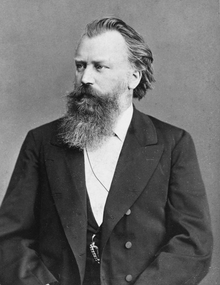| Piano Concerto in B♭ major | |
|---|---|
| No. 2 | |
| by Johannes Brahms | |
 Brahms in 1885 | |
| Opus | 83 |
| Composed | 1878–1881 |
| Dedication | Eduard Marxsen |
| Performed | 9 November 1881: Budapest |
| Movements | four |
The Piano Concerto No. 2 in B♭ major, Op. 83, by Johannes Brahms is separated by a gap of 22 years from his first piano concerto. Brahms began work on the piece in 1878 and completed it in 1881 while in Pressbaum near Vienna. It took him three years to work on this concerto, which indicates that he was always self-critical. He wrote to Clara Schumann: "I want to tell you that I have written a very small piano concerto with a very small and pretty scherzo." Ironically, he was describing a huge piece.[1] This concerto is dedicated to his teacher, Eduard Marxsen. The public premiere of the concerto was given in Budapest on 9 November 1881, with Brahms as soloist and the Budapest Philharmonic Orchestra, and was an immediate success.[2] He proceeded to perform the piece in many cities across Europe.[3]
The piece is scored for 2 flutes, 2 oboes, 2 clarinets (B♭), 2 bassoons, 4 horns (initially 2 in B♭ bass, 2 in F), 2 trumpets (B♭), timpani (B♭ and F, A and D in second movement) and strings. (The trumpets and timpani are used only in the first two movements, which is unusual.)[1]
The piece is in four movements, rather than the three typical of concertos in the Classical and Romantic periods:
- Allegro non troppo (B♭ major)
- Allegro appassionato (D minor)
- Andante (B♭ major—F♯ major—B♭ major)
- Allegretto grazioso—Un poco più presto (B♭ major)
The additional movement results in a concerto considerably longer than most other concertos written up to that time, with typical performances lasting around 50 minutes. Upon its completion, Brahms sent its score to his friend, the surgeon and violinist Theodor Billroth to whom Brahms had dedicated his first two string quartets, describing the work as "some little piano pieces."[3] Brahms even described the stormy scherzo as a "little wisp of a scherzo."[2]
The autograph manuscript of the concerto is preserved in the Hamburg State and University Library Carl von Ossietzky.
- ^ a b "Piano Concerto No. 2 in B-flat major, Op. 83 (Johannes Brahms)". LA Phil. Retrieved 2020-05-20.
- ^ a b Allsen, J. Michael (2002). "Johannes Brahms – Piano Concerto No. 2". Galveston Symphony Orchestra. Archived from the original on April 11, 2010.
- ^ a b Glesner, Elizabeth Schwarm (October 10, 2000). "Johannes Brahms – Piano Concerto No.2, Op.83". Archived from the original on May 28, 2010. Retrieved April 18, 2015.